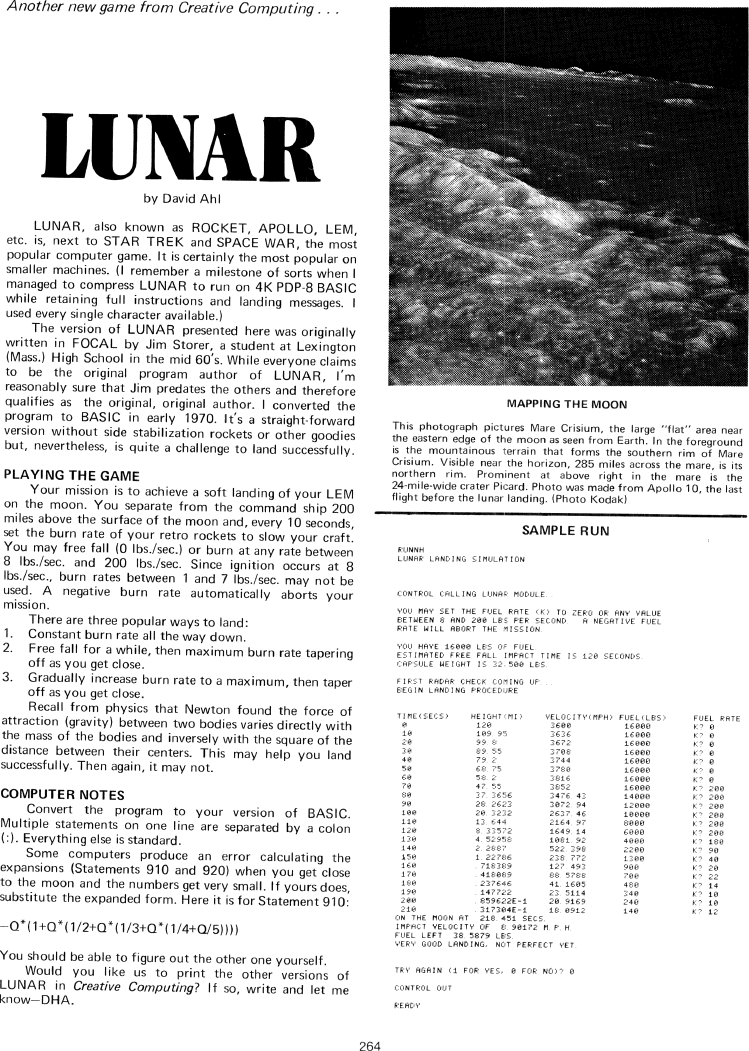The Best of Creative Computing Volume 1 (published 1976)
Lunar (BASIC computer game, lunar landing simulation, LEM, ROCKET, APOLLO, BASIC program listing, sample run,)

Another new game from Creative Computing . .
LUNAR
by David Ahi
LUNAR, also known as ROCKET, APOLLO, LEM, etc. is, next to STAR TREK and SPACE
WAR, the most popular computer game. It is certainly the most popular on smaller
machines. (I remember a milestone of sorts when I
managed to compress LUNAR to run on 4K PDP-8 BASIC while retaining full
instructions and landing messages. I
used every single character available.)
The version of LUNAR presented here was originally written in FOCAL by Jim
Storer, a student at Lexington
(Mass.) High School in the mid 60's. While everyone claims to be the original
program author of LUNAR, I'm
reasonably sure that Jim predates the others and therefore qualifies as the
original, original author. I converted the program to BASIC in early 1970. It's
a straight~forward version without side stabilization rockets or other goodies
but, nevertheless, is quite a challenge to land successfully.
PLAYING THE GAME
Your mission is to achieve a soft landing of your LEM on the moon. You
separate from the command ship 200
miles above the surface of the moon and, every 10 seconds, set the burn rate of
your retro rockets to slow your craft. You may free fall (0 lbs./sec.) or burn
at any rate between 8 lbs./sec. and 200 lbs./sec. Since ignition occurs at 8
lbs./sec., burn rates between 1 and 7 lbs./sec. may not be used. A negative burn
rate automatically aborts your mission.
There are three popular ways to land:
1. Constant burn rate all the way down.
2. Free fall for a while, then maximum burn rate tapering off as you get close.
3. Gradually increase burn rate to a maximum, then taper off as you get close.
Recall from physics that Newton found the force ofattraction (gravity)
between two bodies varies directly with the mass of the bodies and inversely
with the square of the distance between their centers. This may help you land
successfully. Then again, it may not.
COMPUTER NOTES
Convert the program to your version of BASIC.Multiple statements on one line
are separated by a colon
(:). Everything else is standard.
Some computers produce an error calculating the expansions (Statements 910 and
920) when you get close
to the moon and the numbers get very small. If you does, substitute the expanded
form. Here it is for Statement 910:
-Q*(1+Q*(l/2+Q*(1/3+Q*(1/4+Q/5))))
You should be able to figure out the other one yourself.
Would you like us to print the other versions of LUNAR in Creative Computing?
lf so, write and let me
know-DHA.
MAPPING THE MOON
This photograph pictures Mare Crisium, the large "flat" area near the eastern
edge of the moon as seen from Earth. In the foreground is the mountainous
terrain that forms the southern rim of Mare Crislum. Visible near the horizon,
285 miles across the mare, is its northern rim. Prominent at above right in the
mare is the
24-mile-wide crater Picard. Photo was made from Apollo 10, the last flight
before the lunar landing. (Photo Kodak)
SAMPLE RUN
RUNNH
LUNAR LANDING SIMULATION
CONTROL CALLING LUNAR MODULE..
YOU MAY SET THE FUEL RATE <K> TO ZERO OR ANY VALUE BETWEEN 0 AND 200 LBS PER
SECOND. A NEGATIVE FUEL RATE WILL ABORT THE MISSION.
YOU HAVE 16000 LBS OF FUEL. ESTIMATED FREE FALL IMPACT TIME IS 120 SECONDS.
CAPSULE WEIGHT IS 32,500 LBS.
FIRST RADAR CHECK COMING UP... BEGIN LANDING PROCEDURE
TIME<SECS> HEIGHT<MI> VELOCITY<MPH> FUEL<LBS> FUEL
RATE
0 120 3600 16000 K? 0
10 109.95 3636 16000 K? 0
20 99.8 3672 16000 K? 0
30 89.55 3708 16000 K? 0
40 79.2 3744 16000 K? 0
50 68.75 3780 16000 K? 0
60 58.2 3816 16000 K? 0
70 47.55 3852 16000 K? 0
80 37.3656 3476.43 14000 K?
200
90 28.2623 3072.94 12000 K?
200
100 20.3232 2637.46 10000 K?
200
110 13.644 2164.97 8000 K?
200
120 8.33572 1649.14 6000 K?
200
130 4.52958 1081.92 4000 K?
180
140 2.2887 522.398 2200 K? 90
150 1.22706 238.772 1300 K? 40
160 .718389 127.493 900 K? 20
170 .418089 88.5788 700 K? 22
180 .237646 41.1605 480 K? 14
190 .147722 23.5114 340 K? 10
200 .859622E-1 20.9169 240 K? 10
210 .317304E-1 18.0912 140 K? 12
ON THE MOON AT 218.451SECS.
IMPACT VELOCITY OF 8.90172 M.P.H.
FUEL LEFT 38.5879 LBS.
VERY GOOD LANDING, NOT PERFECT VET.
TRY AGAIN < 1 FOR YES, 0 FOR NO>? 0
CONTROL OUT
READY
264


